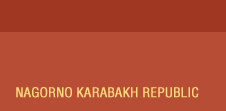Nagorno Karabakh (Artsakh)
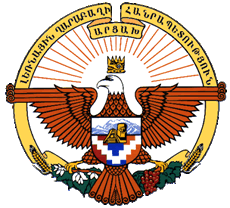 The Gandzasar Monastery is located in the Nagorno Karabakh Republic (NKR), an independent state that emerged as a result of the break-up of the USSR’s Azerbaijani Soviet Socialist Republic into two entities: the Azerbaijani Republic and NKR. Azerbaijan is controlled by a brand of Muslim Turks known today as “Azerbaijanis” or “Azeris.” Nagorno Karabakh Republic is populated by Armenian Christians.
The Gandzasar Monastery is located in the Nagorno Karabakh Republic (NKR), an independent state that emerged as a result of the break-up of the USSR’s Azerbaijani Soviet Socialist Republic into two entities: the Azerbaijani Republic and NKR. Azerbaijan is controlled by a brand of Muslim Turks known today as “Azerbaijanis” or “Azeris.” Nagorno Karabakh Republic is populated by Armenian Christians.
NKR was organized in 1991, on the basis of the Nagorno Karabakh Autonomous Region, which was an ethnic Armenian autonomy subordinated to Soviet Azerbaijan in the Soviet times. Armenians have traditionally called their country Artsakh, a term that refers to one of the 15 provinces of the ancient Kingdom of Armenia. Although “Karabakh,” a geographical concept associated with the legacy of Nagorno Karabakh’s Soviet-era autonomy, is still in use, it is being gradually replaced with the region’s more relevant historical name — “Artsakh.”
Nagorno Karabakh is a small presidential republic, with a population of about 144,000 (2008). It maintains close economic and military ties to its neighbor and ally, the Republic of Armenia. The National Assembly is NKR’s highest legislative and representative body.
The frontiers of the republic are guarded by the Nagorno Karabakh Defense Army, whose units are internationally recognized as the most efficient in the post-Soviet space.
The country is led by President Bako Sahakyan who was elected in the June 2007 poll. He is the third President of the Nagorno Karabakh Republic. President Sahakyan replaced the outgoing President Arkadiy Ghukasyan (1997-2006).
The Foreign Ministry of the Nagorno Karabakh Republic maintains diplomatic representation offices in Armenia, Russia, United States, France, Germany, Lebanon, and Australia.
| |
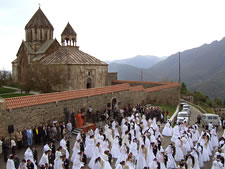
In October 2008, the Gandzasar Monastery hosted an unprecedented wedding ceremony, which married 675 couples from the Nagorno Karabakh Republic
|
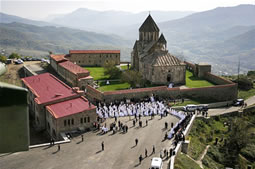
October 2008: soon-to-be married couples lined up near the gate to the Gandzasar Monastery. The mass wedding was organized by Mr. Levon Hairapetian, a Russia-based philanthropist and representative of Armenia’s ancient Hasan-Jalalian dynasty.
|
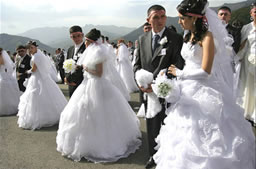
Newlyweds standing in front Gandzasar’s Cathedral of St. John the Baptist.
|
Nagorno Karabakh in Antiquity and the Middle Ages
Artsakh, including today’s Nagorno Karabakh Republic, has been populated and uninterruptedly governed by Armenians, its autochthonous population, since the Roman times.
The territory of modern Nagorno Karabakh was part of the province of Artsakh when the Ervanduni (Orontid) dynasty first established the Kingdom of Armenia after the collapse of the Kingdom of Urartu in the sixth century BC. [1] Artsakh was described by the Greek and Roman authors as an important part of Armenia, which guarded its eastern frontier and provided its military with the best cavalry force. [2]
When the Kingdom of Armenian was partitioned between Persia and Byzantium, in 387 AD, Artsakh’s rulers broke away from the dominion of Armenian kings but soon re-invented their land as a separate Armenian state, the Kingdom of Aghvank. Aghvank, named after one of the grandsons of Hayk Nahapet (Hayk the Forefather, semi-mythical patriarch and eponym of Armenians), expanded its territory to the east and included the lands that modern scholars designate as so-called “Caucasian Albania.” [3]
Armenian culture and civilization flourished in Aghvank: important architectural monuments were built; Mesrob Mashtots—the inventor of the Armenian alphabet—opened his first school at the Amaras Monastery (in circa 410 AD) [4]; first Armenian constitutional edict was introduced by King Vachagan II the Pious around the same time; and lyricists, such as the seventh century author Davtak Kertogh, took Armenian poetry to new heights. [5]
In the Middle Ages, the Kingdom of Aghvank disintegrated into several separate Armenian principalities, which, by the mid-9th century, recognized the authority of the Bagratid dynasts of the reestablished Kingdom of Armenia. These kinglets were later re-assembled by Hasan Jalal Vahtangian, the builder of Gandzasar’s Cathedral of St. John the Baptist, into his Principality of Khachen. [6]
In the late Middle Ages, Artsakh, nominally part of the Persian Empire, became a union of several Armenian feudal entities known in history as The Five Duchies or Khamsa Melikdoms. [7]
Roots of the Nagorno Karabakh Conflict
The mentions of the term “Karabakh” go back to a period between the 16th and mid-18th centuries. “Karabakh” commonly designated Artsakh's extension in the eastern lowlands of Armenia, which experienced the incursion of nomadic Turkic tribes from the Central Asia in the late Middle Ages.
The term Karabakh is of Armenian origin, meaning “Great Baghk” and pointing to the Kingdom of Baghk that in the period between the 10th and the 13th centuries occupied the southern portion of Armenia ’s provinces of Artsakh and Syunik. [8] However, the Turkic nomadic migrants came to use this term for referring to the land of Artsakh because of its phonetic similarity to what appears to be a combination of the Turkic word “Ghara” (meaning “black”) and the Persian word “Bagh” (meaning “garden”). Such phonetic misconstructions appear when a group that arrives to a new land from elsewhere tries to adapt local toponyms to their own language.
As the Turko-Islamic colonization expanded, in Artsakh—as in many places throughout the Near East, Asia Minor and the Balkans—the nomads gradually pushed the indigenous Christians to the mountains, as they assumed control of the plains. As a result, the central and eastern regions of what is now the Azerbaijani Republic lost most of its aboriginal Armenian population who migrated west and found refuge in the impregnable Christian strongholds populated and ruled since the Roman times by Artsakh’s Armenian mountaineers. [9]
However, the economic life of the Turkic nomads, which required access not only to lowland areas but also to hilltop pastures, and their values, which derived from misinterpreted principles of Islam, denied Christians most political and social rights while legitimizing banditry and looting. This eventually pitted the nomadic newcomers and Islamized Armenians against the Christian highlanders too, and established the basis of the historical confrontation between the Armenian natives of Artsakh and the Turkic tribesmen of the Southeastern Caucasus, some of whom chose to be called “Azerbaijanis” in the 1920s.
In the 18th century, however, a long Armenian-Turkish war with Ottoman invaders ravaged Artsakh while internal disagreements further weakened its administration. As a result, in the early 1760s, the Armenian dukes (meliks) of Artsakh succumbed to the pressure of the Muslim tribes, which nearly succeeded in penetrating the region and establishing a parallel Turkic-Armenian rule over the province. The consequence was the proclamation of so-called “Karabakh Khanate,” a short-lived Armeno-Turkic principality in Artsakh that in 1805 was absorbed into the Russian Empire, after 40 years of existence, and abolished. The effect of the Khanate’s collapse was a century of relative stability in regional Muslim-Christian relations. In this period, the regional capital of Shushi developed into an important trade center and produced dozens of outstanding musicians, historians, writers and engineers.
Despite the relatively quick demise of the Karabakh Khanate, some Turkic settlers chose not to return to the eastern steppe, from where they had arrived. Instead, they stayed in Artsakh, limiting their presence to the Muslim quarter of the city of Shushi but turning that settlement into a hub of latent inter-communal tensions.
The Armenian-Turkic conflict in Artsakh was ignited once again with the ascent of the era of nationalism, when in the beginning of the 20th century the Caucasus was plunged into inter-ethnic strife accompanied by pogroms and incidents of mass murder. The largest of such clashes took place in 1905-1906, and is known as the “Armenian-Tartar War” (as mentioned above, the term “Azerbaijanis” was invented in the 1920s; instead, they were referred to as “Tartars” by Russians and “Turks” by Persians, Armenians and Georgians). [10]
Nagorno Karabakh and the Russian Revolution
The situation worsened after the demise of the Russian Empire and emergence of three independent states in the Southern Caucasus— Georgia, Armenia and Azerbaijan —which from the very first days of creation disputed over their borders.
During this tragic period, in March 1920, local Turkic (“Azerbaijani”) Muslims, abetted by expeditionary Ottoman forces, massacred the Armenian population of Shushi and burned down the Christian-populated half of the city. Over 20,000 of Shushi’s residents were killed and 7,000 buildings were demolished. There exists rich photographic material that documented the destruction of Shushi’s Armenian quarters in dozens of black-and-white images. [11]
In 1918-1920, during the Russian civil war, Nagorno Karabakh designated itself as part of Armenia and was a self-ruled Armenian province that had its own government and armed forces which fought against Azerbaijani and Ottoman forces.
In 1920, the Bolshevik armies from Russia re-invaded the Caucasus and forced the three nations inside what later became the Soviet Union.
Nagorno Karabakh under the Bolshevik Rule
In 1921, the Bolsheviks temporarily recognized Artsakh as an integral part of Armenia, together with two other Armenian-peopled regions, Nakhichevan and Zangezur (i.e. ancient Syunik, which remained in Armenia ). However, in an effort to placate the oil-producing Azerbaijan and Bolshevik Russia’s Kemalist allies in Turkey, that decision was reversed, and Joseph Stalin, Russia’s commissar for nationalities (who later became the USSR’s ill-famed dictator), forcibly placed Artsakh under the administration of Soviet Azerbaijan. Nagorno Karabakh’s status of an autonomous region (oblast) was formally confirmed in 1923, an act that was met with enthusiastic protests in the Armenian province.
Thus, Artsakh - Nagorno Karabakh was turned into the world's only Christian territorial autonomy inside a largely Muslim state entity. For the next 70 years, Azerbaijan bombarded Artsakh with various forms of ethno-religious discrimination, economic mistreatment and gerrymandering, in an attempt to eliminate its Armenian Christian majority and replace it with Azerbaijani Muslim settlers.
The USSR’s Nagorno Karabakh Autonomous Region
The premeditated maltreatment of Armenians in Nagorno Karabakh by the authorities in Baku was an open secret that Azerbaijan tried to cover up for some time. However, beginning from 1999, Azerbaijan’s Soviet-era leader and its post-independence President Heydar Aliyev launched a series of public confessions in which he bluntly admitted that the goal of his administration—between 1967 and 1987—was to intentionally abuse the region’s Armenian majority, drive them into exodus and thus change Nagorno Karabakh’s demographic balance in favor of ethnic Azerbaijanis (Source: “Heydar Aliyev: A State is Better Off with an Opposition,” newspaper “Echo” (Azerbaijan), No. 138 (383) CP, July 24, 2002).
In Nakhichevan, Aliyev’s birthplace, which, similarly to Nagorno Karabakh, was placed under Azerbaijani control, this policy resulted in a complete expulsion of Armenians who in the 1930s still comprised one half of all residents. In Nagorno Karabakh, Azerbaijan’s demographic operations stopped the growth of the province’s Armenian majority population and boosted its Azerbaijani minority: as a result, while Armenians kept emigrating, the percentage of ethnic Azerbaijanis increased from 5 percent in 1923 to 24 percent by 1986. [12]
The Armenians of the province periodically petitioned the Kremlin to protect them from Baku’s abusive policies. Mass public appeals signed by thousands of Nagorno Karabakh’s residents—requesting to re-unify their land with Soviet Armenia—were launched in 1935, 1953-55, 1965-67 and 1977.
Although the official Baku’s reaction to Armenian complains was highly negative, Azerbaijan was not able to use violent measures to punish the Nagorno Karabakh people because of regime-specific restraints that characterized the Soviet totalitarian police state. However, when the Soviet leader Mikhail Gorbachev’s liberal policies gradually decreased Moscow’s influence on ruling elites in peripheral union republics, the situation began changing. In Azerbaijan, this resulted in the resurgence of the long-suppressed chauvinist sentiment. By 1987, the intensity and austerity of Baku’s ongoing process of demographic manipulations in Nagorno Karabakh drastically increased, amounting to a stealthy anti-Armenian ethnic cleansing campaign.
As confirmed by President Heydar Aliyev and his lieutenants (such as the Interior Minister, Gen. Ramil Usubov), he pursued this strategy more openly in the provincial capital city of Stepanakert and in areas adjacent to the Nagorno-Karabakh Autonomous Region (especially in the district of Shamkhor), which were not included into the Autonomous Region back in 1923, and where Armenians lost their majority status in the 1960s-70s. [13]
Part of the Azerbaijani campaign was the destruction of Armenian architectural monuments in Soviet Azerbaijan and publication of revisionist narratives by the Azerbaijani Academy of Sciences aimed at purging Azerbaijan’s history of all traces of Armenian political, cultural and demographic presence, and advancing irredentist claims to some territories in Soviet Armenia. [14]
Nagorno Karabakh’s Secession from Soviet Azerbaijan
The people of Nagorno Karabakh, fearing that history was repeating itself and that Azerbaijan's strategy would eventually result in their destruction if met with no resistance, protested by organizing peaceful rallies. They confronted Azerbaijan’s oppression with the first peaceful, pro-democracy movement in the Soviet Union, setting an example for the Soviet leader Mikhail Gorbachev’s perestroika and glasnost. The Nagorno Karabakh Freedom Movement was endorsed by all Soviet human rights activists (e.g. Andrei Sakharov), both inside and outside the USSR. That marked the beginning of the end of the Soviet Empire. It was also supported by analogous freedom movements in the USSR’s Baltic republics.
In an unprecedented example of direct democracy, in February 1988, Nagorno Karabakh’s regional parliament, which for 70 years functioned as a powerless "rubber stamp," officially appealed to Baku and Yerevan to consider the possibility of reunifying their homeland with the Armenian Soviet Socialist Republic. This grassroots initiative stunned the Kremlin, reversing the normal top-down pattern of the Soviet system and its totalitarian Communist Party.
Azerbaijan’s reaction to Nagorno Karabakh’s nonviolent and constitutional measures was totally unexpected and shocking. Instead of responding to Nagorno Karabakh's appeal by launching a constitutional dialogue, the Azerbaijani leadership organized a series of pogroms and massacres of unsuspecting ethnic Armenian civilians living in remote corners of Azerbaijan. This campaign of violence began in February 1988 in the country’s principal city of Sumgait, located hundreds of miles away from Nagorno Karabakh, and continued in Kirovabad (November 1988), Baku (January 1990), and other Azerbaijani cities and towns.
The carefully planned anti-Armenian acts of mass public sadism that defined Soviet Azerbaijan between 1988 and 1991 were unprecedented in the entire history of the USSR and totally incomprehensible by its leadership and ordinary Soviet citizens.
Azerbaijan’s Military Aggression Against Nagorno Karabakh
Azerbaijan’s anti-Armenian attacks in 1988-91 only confirmed Nagorno Karabakh’s worst fears. After proclaiming independence by unilaterally breaking away from the USSR in 1991, Azerbaijan unconstitutionally “abolished” the Nagorno Karabakh Autonomous Region and organized full-scale military aggression against its people. This eventually emptied Azerbaijan of all ethnic Armenians residing in places outside of Nagorno Karabakh’s self-defense zone. Overall, nearly 370,000 Armenians (out of their total number of 475,000, according to the USSR ’s 1979 Census) were permanently displaced from Azerbaijan. Most of them were dumped in refugee camps in Armenia.
Despite all expectations, mass acts of retaliatory vengeance against ethnic Azerbaijanis residing in Armenia and Nagorno Karabakh never took place, chiefly because of vigilantly enforced self-discipline of Armenian activists who did not want to provide the Kremlin an excuse to suppress the Karabakh freedom movement. As to Azerbaijanis, they cared much less because the Kremlin ended up supporting Baku. Nonetheless, Azerbaijani residents of Armenia responded to rumors generated by Baku’s Soviet-style propaganda machine and left the country in a parallel wave of migration.
Before 1991, Azerbaijan depended on anti-reform elements in the Kremlin who defied Gorbachev and regarded the Nagorno Karabakh freedom movement as an initiative that posed danger for the Communist regime because of its liberal and democratic appeal. These reactionary forces considered Azerbaijan as a staunch ally of the Communist dictatorship. To support Baku, the Kremlin placed under Azerbaijan’s disposal Soviet punitive police units that operated together with Azerbaijani death squads against Armenian political activists and defiant Armenian villagers in 1990-1991. In its ethnic cleansing and mass-murder operations, Baku relied on a virtually bottomless pool of ammunition and military hardware that Azerbaijan inherited from the Soviet Army.
In its effort to depopulate Nagorno Karabakh, Azerbaijan employed all available means, including the use of foreign mercenaries. These included several thousand mujahideen fighters from Afghanistan, Chechnya and elsewhere, including those who later became the core of Osama Bin Laden’s Al Qaeda terrorist network.
In 1988-1994, the US Congress, institutions of the European Union as well as Soviet and European human rights organizations protested against these retaliatory actions and expressed their support for the Nagorno Karabakh people in their official proclamations.
In the United States, Article 907 of the Freedom Support Act, passed in 1992, restricted US assistance to Azerbaijan because of its blockades of Armenia and Nagorno Karabakh.
Armenia was limited in its ability to assist their brethren in Artsakh due to the aftereffects of a devastating earthquake that in December of 1988 ruined the country and made one in five of Armenia’s residents homeless. Taking advantage of this situation, Azerbaijan attacked Nagorno Karabakh from every corner and sought to flatten its settlements with aerial and artillery bombardments that mainly targeted civilians. The region’s provincial capital, Stepanakert, was thus reduced to piles of smoldering debris. At the same time, Azerbaijan initiated a total land and air blockade that kept Nagorno Karabakh cut-off from the outside world from mid-1988 to 1992. By 1992, the blockade caused starvation and an outbreak of epidemics throughout the province.
Self-Defense and the Emergence of the Nagorno Karabakh Republic
In response to Baku’s invasion, the people of Nagorno Karabakh organized a heroic self-defense effort. Outgunned and outnumbered, they overcame incredible odds and made painful sacrifices for the right to live in their homeland. In the end, primarily due to their discipline, motivation and superior fighting skills, Artsakh’s Armenians succeeded in driving Azerbaijani occupying forces out of their territory. Another key factor of success of Armenian resistance was the collapse of the USSR, which left Baku without Moscow’s military and political backing.
With the help of volunteer groups that were airlifted into Nagorno Karabakh from Armenia, Nagorno Karabakh’s Armenians also established a wide demilitarized area, the Security Zone, around Nagorno Karabakh. In addition to ending the region’s geographic isolation, the Security Zone became the backbone of the Nagorno Karabakh Republic’s strategic defense system by virtue of encompassing rear territories with key heights and mountain passes. The Security Zone is guarded by the armed forces of the Nagorno Karabakh Republic—the Nagorno Karabakh Defense Army (NKDA).
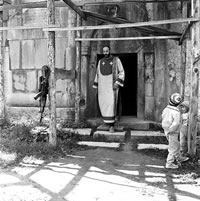
Echo of the war: someone’s Kalashnikov machinegun hanging from scaffolding built around the Cathedral to relieve Gandzasar from the scars of bombardment and neglect. The picture was taken shortly after the ceasefire agreement of 1994, which ended Armenian-Azerbaijani hostilities and established Nagorno Karabakh as an independent state seeking formal international recognition.
Some territories of Nagorno Karabakh proper, however, were never recovered, and to this day they remain under Azerbaijani occupation. These include the entire former Shahumian District, the Getashen sub-region and eastern portions of the districts of Mardakert and Martuni.
In January of 1992, with the disintegration of the USSR, the democratically elected leaders of Nagorno Karabakh exercised their right to self-determination. In accordance with international legal norms and through a referendum based on the USSR’s Law on Secession from union republics (adopted in 1990), they once again re-established Artsakh’s statehood, and instituted a free and sovereign nation—the Nagorno Karabakh Republic.
In May 1994, Nagorno Karabakh, Azerbaijan and Armenia signed a Russian-mediated ceasefire agreement that stopped hostilities. Since that time, the Nagorno Karabakh Republic has been in the process of rebuilding its economy, strengthening the foundations of liberal democracy and preparing itself for the formal recognition by the international community of nations.
Azerbaijan’s “Culture Cleansing”
Nagorno Karabakh Republic, a fledgling Christian democracy, continues being confronted by Azerbaijan—a country that has developed as an archetypal Muslim oil dictatorship since its independence in 1991. Azerbaijan has been hereditarily ruled by the Aliyev clan, a political network from the region of Nakhichevan established in the 1960s by Heydar Aliyev—Azerbaijan’s Soviet-era Communist boss and major-general of the USSR’s secret police (KGB). In 1993, Aliyev staged a military coup and came to power by re-inventing himself as Azerbaijan’s President.
More than eighty percent of Azerbaijan’s state income derives from the sales of crude oil, transported from its capital Baku via the Baku-Tbilisi-Ceyhan pipeline to the Mediterranean Sea. Not surprisingly, like in Nigeria, Libya, Iraq and other oil autocracies, a key characteristic of Azerbaijan’s political and economic system is corruption. The Transparency International, a global NGO that studies and fights corruption around the world, has routinely been ranking Azerbaijan as one of the world’s five most corrupt countries.
Azerbaijan has been a hub of Islamic terrorism and a hot spot for drug trafficking. In August 1998, the Azerbaijani branch of the "Islamic Jihad" organization, which by then had merged with Osama Bin Laden's AI Qaeda, coordinated the bombings of the US Embassies in Kenya and Tanzania that killed 224 people and wounded nearly 4,600. The FBI was able to trace about 60 phone calls made from the satellite phone used by Bin Laden to his associates in Baku, and from them—to operatives in East Africa.
When Heydar Aliyev died in 2003, Azerbaijan presidency passed to Ilham Aliyev, his only son, through a staged election. Like his father, Ilham rules with an iron fist, suppressing political dissent and quashing free press. [15]
Ilham Aliyev made Azerbaijan more, not less, belligerent. Since the beginning of operation of the Baku-Tbilisi-Ceyhan oil pipeline in 2006, when more oil money began swelling state coffers, there has not been a month without Ilham declaring that he wants to use the oil money to start a new war against the Armenians, conquer Nagorno Karabakh and expel its population.
In addition to being an autocrat, Ilham Aliyev is a passionate Azerbaijani chauvinist. His sworn enemies include not only human beings but also thousands of ancient Armenian historical and cultural monuments that still densely cover the western half of his state.
In 2006, Ilham ordered to destroy almost all Armenian churches, monasteries and cemeteries in his father’s birthplace of Nakhichevan (Naxcivan), an Azerbaijani-held exclave sandwiched between Armenia and Iran. Nakhichevan was cut off from Armenia and given to Azerbaijan because of pressure from Turkey, in the 1920s. The demolitions have created an international outcry, largely because of filmed annihilation—by the Azerbaijani Army—of thousands of intricately-carved khachkar tombstones standing in the world-famous medieval cemetery in Jugha (Julfa). Khachkars are unique-to-Armenia art form, representing large stone slabs with engraved Christian cross that are used for various memorial purposes. Western press compared Azerbaijani vandalism in Jugha with the destruction of the statute of Buddha in Afghanistan by the Taliban militia in 2001. [16]
Azerbaijani historians have been publicly instructed by the Aliyevs to rewrite history textbooks, cleansing Azerbaijan’s history of anything non-Azerbaijani. This, however, has been an arduous if at all accomplishable task. The reason is obvious: “Azerbaijanis” are not native to “Azerbaijan,” and they barely left any cultural trace on the land they presently occupy. Azerbaijanis, a Turkic people, who speak a dialect of Turkish, migrated to the Southern Caucasus from the Central Asia (Turkistan) in the late Middle Ages, and remained since then largely a collection of semi-nomadic tribes, especially in the Christian-peopled highlands west of the River Kura.
Unlike Azerbaijan’s neighbors of Armenia, Georgia and Iran (Persia), whose unique cultures and states have existed continuously from the ancient times, an entity called “Azerbaijan” is a phenomenon of the 20th century. After exploring various options, Azerbaijani political leaders decided to name their self-proclaimed state, in 1918, after a bordering province of Persia called “Azerbaijan” (where a large number of Turkic-speaking Persians lived). That immediately caused a sharp diplomatic reaction from Tehran, which accused Baku of “toponymic embezzlement.” Rejection of Azerbaijan’s independence by the League of Nations soon followed. To fully grasp the absurdity of the situation imagine Germans deciding to name their country “Burgundy” or “Venice,” with France or Italy protesting, and with the UN refusing to recognize its sovereignty.
Plus, no people called “Azerbaijanis” or “Azeris” were known prior to the 1930s. These terms were invented by Bolshevik anthropologists in the course of what is known in academic literature as the USSR’s “nativization” (“indigenization”) project. By the Kremlin’s order, a task force of Bolshevik scholars engineered new names for dozens of obscure nationalities of the former Russian Empire, and invented for them claims to historical continuity. [17] This included the Turkic-speakers of the Southern Caucasus that had been obscurely referred to by bureaucrats of the Russian Empire as “Caucasian Tartars.” Before the 20th century, these “Caucasian Tartars,” lacking self-definition as one people, identified themselves either very broadly, as “Muslims,” or very narrowly—as members of specific tribes, clans or urban communities (e.g. Afshars, Padars, Igirmidort, Sarijalli, etc.). Moscow also instituted standard surnames for Azerbaijanis—based on Arabic forenames plus the Russian “ov” ending bolted on, and created a Cyrillic-based alphabet for their, largely unwritten, language.
At present, Azerbaijani historical revisionism is met with exposure and increasingly strong condemnation in Western academia. Disturbingly, however, Baku’s oil autocrats ignore these warnings, and continue regarding Armenian historical and cultural monuments found on the territory of the former Azerbaijani Soviet Socialist Republic as a direct threat to Azerbaijani identity and statehood. More practical steps are to be taken to neutralize this policy as soon as possible. Should a focused international effort fail to stop Azerbaijani cultural vandalism, more artifacts of ancient Christian cultures of the Southern Caucasus will forever be lost, defaced or intentionally misattributed by Azerbaijani “scholars.”


